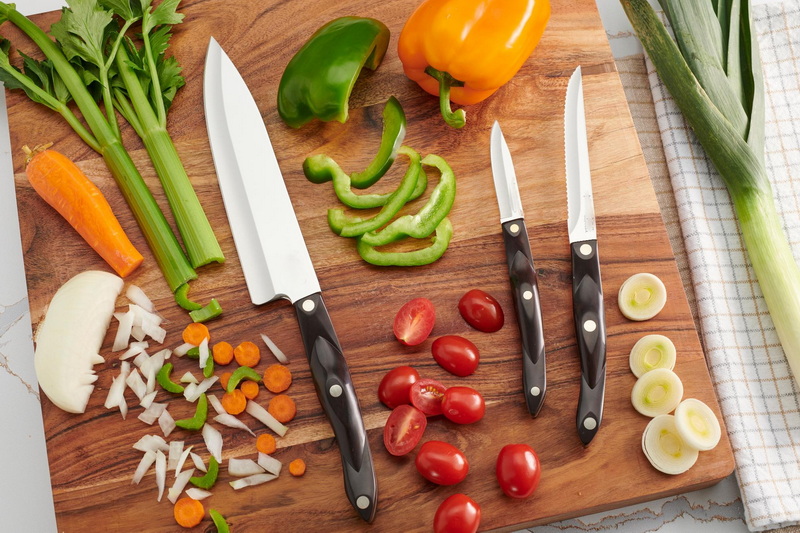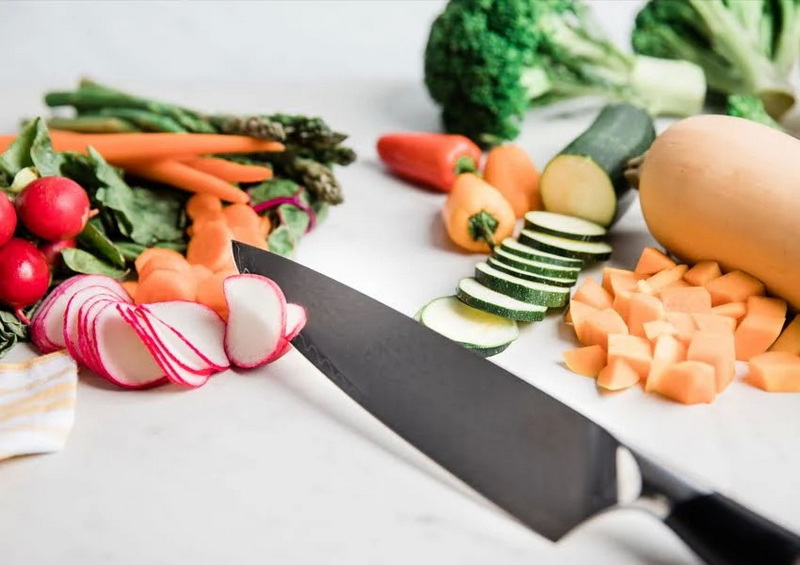

Views: 222 Author: Ella Publish Time: 2025-05-24 Origin: Site








Content Menu
● The Appearance and Design of a Vegetable Knife
>> Blade Material and Construction
>> Handle Materials and Design
● How to Recognize a Vegetable Knife Visually
● Uses and Advantages of a Vegetable Knife
>> Efficient Peeling and Shaping
>> Versatility in Vegetable Preparation
>> Differences Compared to Other Knives
● Popular Types of Vegetable Knives
>> Nakiri (Japanese Vegetable Knife)
>> Usuba (Japanese Single-Beveled Vegetable Knife)
>> Tomato Knife
● How to Use a Vegetable Knife Effectively
● Care and Maintenance of Vegetable Knives
● FAQ
>> 1. What is the difference between a Nakiri and a Usuba vegetable knife?
>> 2. Can a vegetable knife be used for cutting meat?
>> 3. How should I hold a vegetable knife for best control?
>> 4. What materials are best for vegetable knife handles?
>> 5. How do I maintain the sharpness of a vegetable knife?
A vegetable knife is a specialized kitchen tool designed primarily for cutting, peeling, and preparing vegetables and fruits. Its design is distinct from other kitchen knives, optimized for precision and ease in handling plant-based ingredients. Whether you are a professional chef or a home cook, understanding the unique features of a vegetable knife can greatly enhance your cooking experience.

Vegetable knives typically have a broad, thin, and flat blade with a straight cutting edge. Unlike chef knives, which often have a curved edge for rocking motions, vegetable knives feature a straight blade that allows clean, precise cuts without crushing or splitting delicate vegetables. The blade often has a squared-off or slightly rounded tip, making it ideal for chopping and slicing vegetables quickly and efficiently.
Some common types of vegetable knives include:
- Nakiri: A traditional Japanese vegetable knife with a rectangular, thin, and broad blade. It has a flat, blunt tip and a straight cutting edge, perfect for chopping, slicing, dicing, and mincing vegetables. The blade is double-beveled, ground on both sides for balanced cuts. Nakiri knives excel at making clean cuts on hard vegetables like squash and root vegetables without damaging the skin.
- Turning Knife: A smaller knife with a curved blade designed for peeling and shaping round vegetables and fruits such as potatoes and apples. Its shape allows for precise control in shaping and peeling tasks.
- Tomato Knife: A small knife with a serrated blade designed to cut through the tough skin of tomatoes without crushing the soft interior. It often features a forked tip for removing seeds.
- Peeling Knife: A small knife with a sharp blade and ergonomic handle, used primarily for peeling vegetables and fruits with precision, removing only the thin outer layer to minimize waste.
The blade of a vegetable knife is usually made from high-quality stainless steel or carbon steel. Stainless steel blades offer excellent corrosion resistance and require less maintenance, making them ideal for everyday use. Carbon steel blades, on the other hand, are prized for their superior sharpness and edge retention but require more careful maintenance to prevent rust.
Many vegetable knives feature a full tang construction, where the blade extends through the handle, providing better balance and durability. Some premium knives also incorporate layered Damascus steel, which not only enhances the blade's strength but also adds a beautiful aesthetic pattern.
The handle of a vegetable knife is crucial for comfort and control during use. Handles can be made from various materials, including:
- Wood: Offers a warm, natural feel and comfortable grip. Traditional Japanese knives often feature wooden handles made from magnolia or rosewood.
- Metal: Durable and modern-looking, metal handles are often found in Western-style knives but can be heavier.
- High-quality plastic or composite materials: Hygienic, durable, and often ergonomically shaped for safety and ease of handling. Materials like Micarta or resin composites provide excellent grip, even when wet.
Some high-end vegetable knives feature ergonomically shaped handles crafted with precision for a pleasant feel and secure grip during cutting tasks. The handle design often complements the blade's balance, reducing hand fatigue during prolonged use.
Identifying a vegetable knife at a glance involves noting several key characteristics:
- Blade Length: Usually shorter than chef's knives, typically ranging from 5 to 7 inches, allowing better control for delicate vegetable work.
- Blade Width: Broad and flat, enabling scooping of chopped vegetables from the cutting board.
- Blade Edge: Straight and very sharp, often thinner than other knives to reduce resistance and allow clean cuts.
- Tip: Squared-off or slightly rounded, not pointed like a chef's knife, which helps avoid accidental piercing and is safer for chopping.
- Handle: Ergonomically designed for comfortable grip and control, often lighter to balance the thin blade.
Vegetable knives excel at precise, even cuts essential for professional-looking dishes. They allow fine julienne strips, brunoise cubes, wafer-thin slices, and other delicate cuts that enhance the texture and presentation of vegetable dishes. The straight blade edge ensures that vegetables are sliced cleanly without tearing or bruising, preserving their natural appearance and flavor.
With a sharp, thin blade and ergonomic handle, vegetable knives make peeling fruits and vegetables easier and more efficient, removing only the skin without wasting the edible parts. The turning knife variant, with its curved blade, excels at shaping and peeling round vegetables such as potatoes, carrots, and apples, allowing for smooth, controlled movements.
Vegetable knives are indispensable for daily kitchen tasks such as chopping herbs, portioning vegetables for soups and stews, and preparing salads. Their design supports quick, efficient food preparation with minimal effort. The broad blade also doubles as a scoop, making it easy to transfer chopped vegetables from the cutting board to the pot or pan.
Feature | Vegetable Knife | Chef Knife |
Blade Shape | Broad, flat, straight edge, squared or rounded tip | Curved edge, pointed tip |
Blade Thickness | Thin, reduces resistance | Thicker, designed for versatile cutting |
Blade Length | Shorter | Longer |
Cutting Motion | Push-forward and pull-back | Rocking motion |
Primary Use | Vegetables and fruits | Meat, vegetables, general purpose |
Vegetable knives are specialized for plant-based ingredients, while chef knives are more versatile but less precise for fine vegetable work.

- Rectangular blade, straight edge, flat tip.
- Thin blade for clean cuts.
- Double beveled.
- Ideal for chopping, slicing, dicing vegetables.
- Not suitable for cutting bones or very hard materials.
- Single bevel for intricate slicing.
- Heavier and longer blade than Nakiri.
- Used for professional-level precision cutting.
- Requires more skill to use due to single bevel edge.
- Small blades for peeling and light cutting.
- Ergonomic handles.
- Used for detailed work on fruits and vegetables.
- Often curved or pointed for maneuverability.
- Serrated blade to cut tough skins.
- Small size for precision.
- Forked tip for seed removal.
Using a vegetable knife correctly maximizes its potential and ensures safety:
- Use a stable cutting board made of wood, plastic, or rubber to avoid dulling the blade.
- Employ a push-forward and pull-back cutting motion rather than rocking. This technique leverages the straight blade edge for clean cuts.
- Hold the knife with a pinch grip near the blade for better control. Place your thumb and index finger on either side of the blade just above the handle, while the other fingers wrap around the handle.
- Use the flat side of the blade against your knuckles for safe and precise cuts, guiding the knife while protecting your fingers.
- For slicing round vegetables, create a flat surface by cutting them in half or trimming a thin section to stabilize the vegetable and prevent rolling.
- Regularly hone the blade with a sharpening steel to maintain its edge and schedule professional sharpening as needed.
Proper care extends the life and performance of your vegetable knife:
- Cleaning: Hand wash immediately after use with warm, soapy water. Avoid dishwashers as harsh detergents and high heat can damage the blade and handle.
- Drying: Dry the knife thoroughly to prevent rust, especially for carbon steel blades.
- Storage: Store in a knife block, magnetic strip, or protective sheath to protect the blade and prevent accidents.
- Sharpening: Regular honing maintains the edge, but periodic sharpening with a whetstone or professional service is necessary to restore the blade's sharpness.
- Cutting Surface: Use wooden or plastic cutting boards to prevent dulling the blade. Avoid glass, stone, or ceramic surfaces.
A vegetable knife is a uniquely designed kitchen tool with a broad, thin, and flat blade optimized for precision cutting, peeling, and preparing vegetables and fruits. Its straight edge and ergonomic handle provide excellent control and efficiency, making it indispensable for both home cooks and professional chefs focused on vegetable-based dishes. Understanding the distinct features and proper use of vegetable knives can greatly enhance your cooking experience, allowing you to prepare vegetables with speed, accuracy, and style. Proper care and maintenance ensure your vegetable knife remains sharp and reliable for years to come.

Nakiri knives have a double-beveled, thin rectangular blade suitable for home cooks and general vegetable cutting, while Usuba knives are single-beveled, heavier, and designed for professional-level precision slicing and intricate vegetable preparation.
Vegetable knives are not designed for cutting meat or bones. Their thin blades can be damaged by hard materials. For meat, a chef's knife or specialized boning knife is recommended.
Use a pinch grip by placing your thumb and index finger on either side of the blade near the handle, with the rest of your fingers wrapped around the handle. This grip offers maximum control and reduces hand fatigue.
Wood offers a natural, comfortable grip; metal provides durability and modern aesthetics; high-quality plastic or composite materials are hygienic and durable. Ergonomically shaped handles improve safety and comfort during use.
Always use a wooden, plastic, or rubber cutting board to prevent dulling. Avoid cutting on glass, ceramic, or stone surfaces. Regular honing and professional sharpening will keep the blade sharp and effective.